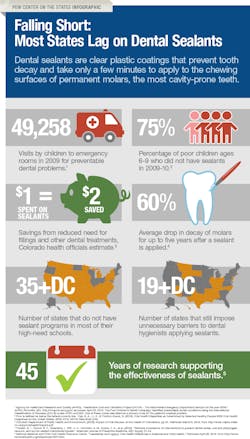The U.S. isn't doing enough to prevent tooth decay, says Pew report
January 8, 2013
Yesterday, the Pew Center on the States published a report on dental sealant use in the U.S. and concluded that most states are not doing enough to prevent tooth decay, driving up the cost of health care for everyone.
AGD comments on Pew report regarding sealants and tooth decay in children
The assessment was based off of state policies that were in place as of July 1, 2012.
- Having sealant programs in high-need schools
- Allowing hygienists to place sealants in school-based programs without requiring a dentist’s exam
- Collecting data regularly about the dental health of school-children and submitting it to a national oral health database, and
- Meeting a national health objective on sealants.
Christine Nathe, RDH, MS, RDH Public Health column editor and author of Dental Public Health and Research (3rd edition published by Pearson), weighed in on the findings:
"I feel that it is compelling that [the Pew Center on the States] highlights the delivery of preventive dental care, specifically in the schools," she told me. "Moreover, it is refreshing that an agency that does not represent dental hygiene realizes the importance of allowing dental hygienists to place sealants in school-based programs without requiring a dentist's exam. Focusing on the four indicators that they utilized is a wonderful mechanism to use when developing solutions to preventive dental care issues."
Five states (Alaska, North Dakota, Wisconsin, New Hampshire, and Maine) earned an “A,” five others (Hawaii, Montana, Wyoming, North Carolina, and New Jersey) earned an “F,” and the rest fell in between, with 37 states earning a grade of “C” or below. (The District of Columbia was also graded – it earned an “F.”)
The report found that:
- 35 states and D.C. do not have sealant programs in most high-need schools. Four states don’t have programs in these schools at all.
- 19 states and D.C. regulate hygienists and restrict them from providing sealants to more children before a dentist has performed an examination. The Center calls this prerequisite outdated.
- Of the five states that earned an “A,” there is still much room for improvement, as thousands of children at risk for decay are not receiving preventive care, such as sealants.
- Of the eight states that received a “B,” five failed to meet the Healthy People 2010 objective. Half did not have sealant programs in most high-need schools.
According to the report, two main changes should be made to improve preventive care in the U.S.: more high-need schools should have sealant programs (that means that Montana, Wyoming, Oklahoma, and Missouri should implement the programs, which they don’t have at this point), and rules restricting hygienists from applying sealants should be revised. In 15 states, a dentist’s exam is not required in order for a hygienist to place a sealant in a school.
View the PDF of the report: Falling Short: Most States Lag On Dental Sealants.


